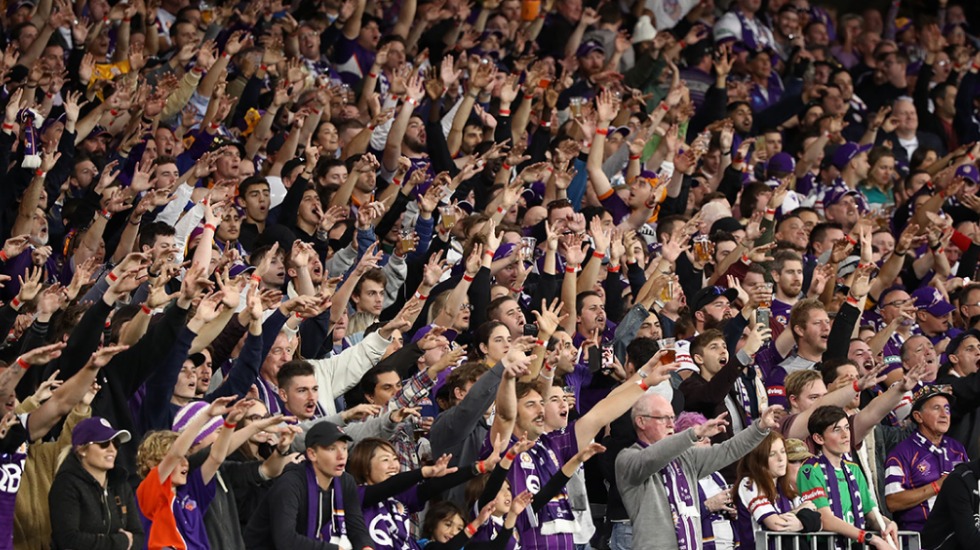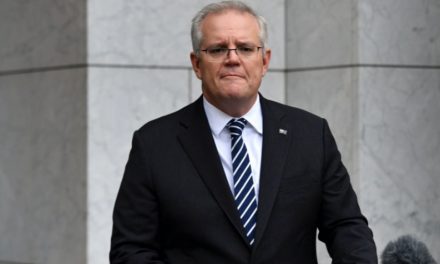Full stands must be the priority for the A-League competitions this year, according to Simon Hill. Photo: Perth Glory.
There was an encouraging development in football in Australia this week – one that would have probably passed most people by.
Not the announcement of the next phase of Wanderers Football Park in western Sydney (as welcome as that is), but Perth Glory’s push to “Fill the (HBF) Park” for Daniel Sturridge’s debut against Adelaide United on the first weekend of the new A-League Men’s season.
While this might seem a small thing to be getting excited about, it represents something of a shift in mentality for the game here. If it is replicated elsewhere, there are genuine grounds for optimism in the new era.
Why?
Because fans have been the missing link in discussions over the last few years. We’ve heard plenty about politics, lots about coaching, and whole tomes could be offered up on the subject of youth development. They are all important topics, but the elephant in the room has been largely ignored.
Without supporters in the stands, the game will continue to exist on the periphery of Australian mainstream sport.
Just a few short years ago, the A-League was on the up. In 2016-17, six of the 10 clubs posted average attendance figures of over 10,000. In round one, almost 62,000 rocked up to Olympic Park to watch the Sydney derby. The Melbourne equivalent a week later was watched by over 43,000, with Tim Cahill taking centre stage after scoring a quite brilliant goal.
Later that campaign, Sydney FC posted another 40,000-plus crowd for the return derby, with City pulling in nearly 25,000 for the second instalment of the Melbourne rivalry.
The overall average that year was 12,294, with the sell-out grand final (between Sydney and Victory) watched by over 41,000 at the Sydney Football Stadium. It’s no surprise that with bigger crowds came bigger interest in watching on television – almost two million for that final on Fox Sports and SBS combined. The game was back page news, and infiltrating news bulletins and radio shows all around the country.
In 2018-19 (the last full season of crowds before the pandemic hit), that figure had dropped to 10,411, and only three clubs posted 10,000-plus averages. News Corp’s waning interest, heavy-handed policing of active supporters, and a three-year political war between the governing body and the clubs were all contributing factors.
COVID-affected numbers have dipped further, and while the clubs can’t be blamed for that, there’s no doubt that this season needs to see an upward trajectory in terms of bums on seats.
The recent Matildas internationals showed us how important crowds are to football. The noisy Brazilians in particular made for a great atmosphere, contributing hugely to the spectacle – and, I’d argue, lifting the players too.
It helped of course, that the games were played in a proper rectangular stadium, with stands close to the pitch, on a pristine surface, and in temperate weather, conducive to fast-paced football. It was the perfect cocktail for the game to put on its prettiest face.
In most of the world, this is a given. In Australia, this confluence of perfect circumstance is tough to construct. In a country with four football codes sharing stadiums, and a sport being played in the hot summer months, it’s not always easy to produce ideal conditions for our code of football.
But the game is starting to try and do the right thing. As of this season, there will be two Saturday games with evening kick-offs (when temperatures are cooler) – one broadcast live on Channel 10, the other on Paramount Plus.
The penny is dropping for the clubs, too.
Brisbane Roar dumped Suncorp Stadium last season for Dolphin Stadium in Redcliffe. It’s out-of-town location isn’t universally popular, but its more intimate feel is much better for A-League football than the 52,000-capacity ground at Milton.
Melbourne Victory will follow suit this year by ditching Marvel Stadium as one of its home grounds. The facility at Docklands is a great stadium, and perfect for grand finals where a big crowd is guaranteed – but for regular-season fixtures, its cavernous surrounds, and occasionally questionable surface, leaves fans (and players) frustrated. AAMI Park, though, is fit for purpose.
PLEASE HELP US CONTINUE TO THRIVE BY BECOMING AN OFFICIAL FOOTYOLOGY PATRON. JUST CLICK THIS LINK.
Sydney FC will soon be back in their preferred home at the SFS, while Hindmarsh Stadium in Adelaide is getting a much-needed revamp ahead of the FIFA Women’s World Cup in 2023. Build it, and they will come. Western United take note.
But come they must. For too long, the A-League prioritised the mainstream fan ahead of the committed football follower. Australian Professional Leagues managing director Danny Townsend has signalled a change in that approach, saying in June: “The APL is all about driving outcomes for the fans, and (to) provide a better experience for them.”
Words, of course, need to be backed up with actions, but they are a start towards recreating the sort of atmosphere that made football the must-see experience just a short time ago.
Active fans in particular must be encouraged – not to break the law, but to support their club in the way that is unique to the sport. Get that right, and the “mainstream” fan will come anyway, drawn by curiosity – as they were when the Western Sydney Wanderers first exploded onto the scene back in 2012.
All of which is why it’s good to see Glory lead the way in brazenly trying to “fill the park”. They might not get there – and ticket prices are already a bone of contention – but their ambition is to be applauded. It’s not the first time they have done this, and their last attempt produced a pretty good result.
In 2019, a six-week advertising campaign produced a crowd of 17,856 for the game against Melbourne Victory, smashing their home attendance record.
Big crowds not only inspire players and create atmosphere, they look and sound good on television too. Are you more likely to remain tuned in to watch a game that has an atmospheric backdrop played in a compact stadium in cool conditions? Or one played out before a few thousand in a cavernous bowl on a blazing hot summer’s day?
These are things the APL (the umbrella body now running the leagues) has to try and get right more often than not in the new era. If fans can be encouraged to part with their hard-earned cash to turn up on a regular basis, then the knock-on effects for the game are huge.
I’d actually like to see the APL go further, and set KPIs for clubs on crowds throughout the coming seasons. This is particularly true for the newly-renamed A-League Women’s competition.
While the Matildas are now firmly established as a brand among the sporting public, the true test for the female game in the era of professionalism is to attract fans to watch the domestic league.
The last season of the (formerly-named) W-League before the pandemic (2018-19) drew an average crowd of just 1528 for the season.
In fact, this is an issue for women’s club football around the globe. Despite heavy investment in the FA Women’s Super League in England for example, the biggest crowd this season remains the 8705 that turned up to watch Arsenal defeat Chelsea in September.
Football in Australia can rightly jump up and down with excitement about the new era ahead. A new TV deal, a Women’s World Cup heading this way in 2023, investment signalled via private equity, a new national second division being actively discussed.
Yet the real measure of success will be the engagement of the most important people in the game. The people who are often ignored – yet are invaluable. I’ll leave you with the words of the late, great Jock Stein, European Cup-winning manager of Celtic in 1967: “Football without the fans is nothing. It could be the greatest game in the world, but if there are no people there to watch it, it becomes nothing. Fans are the lifeblood of the game.”












Excellent Article.